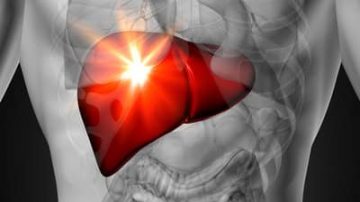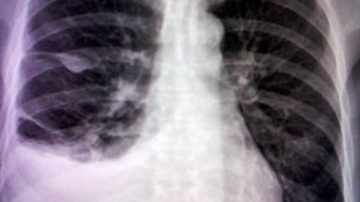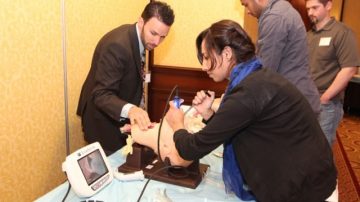This blog will offer some expert recommendations to help guide the safety of hospital procedures at different platelet and coagulation profiles. Unfortunately, there are no strong evidence-based guidelines for hospital procedures dedicated to the study of patients with decompensated cirrhosis.…
Read MorePatients diagnosed with cirrhosis are regularly admitted and readmitted to the hospital. Statistics show that the 90-day readmission rate is approximately 50%. A recent study analyzed the rate of readmission at 30-days and 90-days and the relevant causes among patients…
Read MoreA historical myth in procedural medicine is the operator should limit removal of pleural fluid to 1.5 L during thoracentesis because of the risk of re-expansion pulmonary edema or pneumothorax. New evidence supports safety of large volume thoracentesis until no…
Read MoreHow to Differentiate Pleural Effusion Exudates from Transudates Historically, Light’s criteria have been used to classify pleural effusions into transudates or exudates. Light’s criteria were established by Dr. Richard Light in 1972.[1] These criteria maximize sensitivity but have a…
Read MoreBased on several studies, central line malposition occurs between 3.3-6.7% of the time.1 The historical recommendation is that malpositioned central lines should not be used for long periods of time, if at all. The basis for these recommendations is based…
Read MoreWhere to place a central venous catheter is a decision driven mainly by individual preference. The limited evidence available has not established any site as superior; the subclavian position has been reported as being less infection-prone, but more likely to cause…
Read MoreA study from an urban EM residency program determined that in-plane ultrasound-guided central venous catheterization is superior to out-of-plane ultrasound-guided central line placement. This study was only a single center study that was a randomized crossover study of ER residents…
Read MoreMore Tags – central lines, central venous catheters, featured, femoral lines, HPC updates, IJ lines, subclavian lines
The internal jugular or subclavian veins have fewer combined mechanical or infectious complications for central venous catheter insertions compared with femoral vein CVC placements. Numerous organizations have proposed guidelines or central line bundles that have advocated preferential use of the…
Read MoreA study from an urban EM residency program determined that in-plane ultrasound-guided central venous catheterization is superior to out-of-plane ultrasound-guided central line placement. This study was only a single center study that was a randomized crossover study of ER residents…
Read MoreHow do we assess a cirrhotic patients bleed risk prior to a planned bedside procedure? Can our standard platelet count and coagulation studies, prothrombin time (PT/INR) and partial thromboplastin time (aPTT), accurately predict bleed risk in cirrhotic patients? The quick…
Read MoreThis blog summarizes a recent update reviewing current management recommendations for hepatic hydrothorax (HH). Hepatic hydrothorax is a complication of decompensated cirrhosis with portal hypertension. Sixty percent of patients accumulate both ascitic fluid and pleural fluid as a result of portal…
Read MoreTransfuse Plasma, Platelets and Red Blood Cells in a 1:1:1 Ratio in Severely Injured Trauma Patients
In recent years, the dogma regarding large-volume crystalloid resuscitation in trauma patients has changed, with increased emphasis on including plasma and platelets in addition to red blood cells in the immediate resuscitation protocol. The long-awaited PROPPR trial compared the safety and…
Read MoreVideo Laryngoscopy Is Superior to Direct Laryngoscopy for Failed Intubation Attempts in the ER Although video laryngoscopy has repeatedly been shown to be superior to direct laryngoscopy, there has not yet been any specific directive instructing emergency department (ED) intubators…
Read MoreThe Difficult Airway Society (DAS) has recently published new guidelines for awake tracheal intubation (ATI) in adults. When performed correctly, ATI has a favorable safety profile for patients with an anticipated difficult airway. The guidelines cover the indications for ATI,…
Read MoreAccording to AASLD Practice Guidelines, all patients with cirrhotic ascites admitted to the hospital should have a diagnostic paracentesis to rule out spontaneous bacterial peritonitis (SBP). Treatment of SBP requires cefotaxime plus albumin 1.5 gm/kg on the first day and…
Read MoreCategories
- ACLS (1)
- Arterial line (33)
- Cardiovascular diseases (77)
- Central line (55)
- Chest Tube (39)
- Dermatology (4)
- Emergency Procedures (139)
- Endocrinology (6)
- Endotracheal Intubation (36)
- Events (24)
- FAST Exam (12)
- Featured (113)
- Featured Procedure (42)
- Gastrointestinal diseases (32)
- Ginecology (3)
- Glidescope Intubation (21)
- Hematology (33)
- Hospital Procedures (85)
- Infections (32)
- Intraosseous line (8)
- King Tube (27)
- Laryngeal Mask Airway (18)
- Lumbar Puncture (36)
- Mechanical Ventilation (34)
- Medical General (95)
- medical procedures (258)
- Needle Decompression (6)
- Nephrology (11)
- Neurological diseases (12)
- Oncology (4)
- Paracentesis (32)
- Pericardiocentesis (3)
- Procedural Sedation (19)
- Respiratory diseases (85)
- RUSH Exam (8)
- Thoracentesis (37)
- Traumatology (24)
- Travel (27)
- Ultrasound-Guided Peripheral IV (13)













